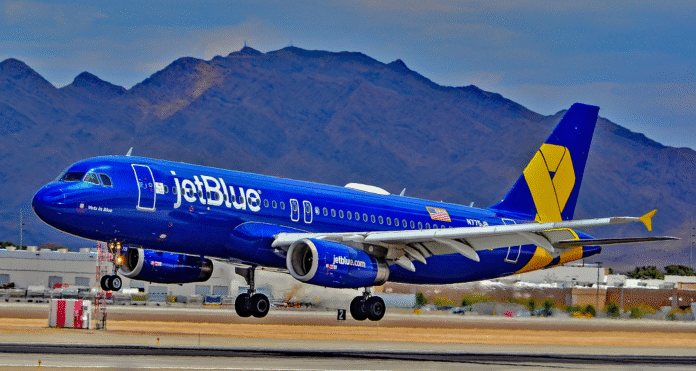JetBlue has partnered with Amazon’s Project Kuiper to become the first airline globally to integrate next-generation satellite Wi-Fi technology. This collaboration, announced in September 2025, will enhance JetBlue’s free Fly-Fi service, offering faster speeds, lower latency, and seamless connectivity for passengers. The initiative aligns with JetBlue’s JetForward strategy to prioritize customer-centric innovations and solidify its leadership in in-flight experiences. With Project Kuiper’s low Earth orbit (LEO) satellites, JetBlue aims to redefine air travel by enabling high-bandwidth activities like streaming, gaming, and remote work from gate to gate.

Why Project Kuiper Is a Game-Changer for Aviation Wi-Fi?
1. Superior Technology Compared to Traditional Systems
Project Kuiper uses LEO satellites orbiting at 367–391 miles above Earth, significantly reducing latency and increasing reliability compared to geostationary (GEO) satellites, which operate at 22,369 miles. This technology minimizes signal delay, enabling real-time activities like video calls and live streaming. JetBlue’s current Fly-Fi relies on GEO satellites, which struggle with latency and bandwidth limitations. The shift to LEO will address these issues, providing download speeds up to 1 Gbps per device.
2. Free, High-Speed Connectivity for All Passengers
JetBlue is the only major U.S. airline to offer complimentary Wi-Fi across its entire fleet. The partnership with Project Kuiper ensures this perk continues, with enhanced performance. From browsing to bandwidth-intensive tasks, passengers will enjoy uninterrupted service without hidden fees. This differentiates JetBlue from competitors like United and Hawaiian Airlines, which charge for Wi-Fi or partner with services like Starlink.
3. Multi-Orbit Future-Proofing
JetBlue plans to explore a multi-orbit solution combining LEO and GEO networks for maximum coverage and redundancy. This hybrid approach ensures reliability over oceans and remote regions where LEO satellites might have limited reach. The flexibility positions JetBlue ahead of rivals adopting single-system solutions.
Key Benefits for Travelers
- Streaming and Gaming: Buffer-free 4K video streaming and online gaming.
- Remote Work: Stable video conferencing and cloud-based tools.
- Global Coverage: Consistent service on domestic and international routes.
- No Cost: remains free, unlike paid services on other airlines.
Implementation Timeline and Rollout Plan
- 2025: Project Kuiper accelerates satellite deployments, with 100+ satellites already launched.
- 2027: JetBlue begins installing Kuiper terminals on select aircraft, starting with long-haul routes.
- Phased Expansion: Full fleet integration by 2030, prioritizing Airbus A321neo and A220 models.
Comparative Analysis: JetBlue vs. Competitors
| Airline | Wi-Fi Provider | Cost | Technology | Speed/Latency |
|---|---|---|---|---|
| JetBlue | Project Kuiper (LEO) | Free | LEO + GEO | Up to 1 Gbps, low latency |
| United Airlines | Starlink (LEO) | Paid | LEO | High speed, variable |
| **Hawaiian Airlines | Starlink (LEO) | Paid | LEO | Moderate speed |
| Delta | Viasat (GEO) | Free/Paid tiers | GEO | High latency |
Source: Amazon Project Kuiper and industry reports .
Challenges and Solutions
- Regulatory Hurdles: Compliance with global aviation and telecom regulations. Solution: Amazon’s collaboration with international agencies.
- Technical Integration: Retrofitting aircraft with phased-array antennas. Solution: Phased rollout to minimize operational disruptions.
- Competition: Staying ahead of rivals adopting LEO tech. Solution: Continuous innovation through JetBlue’s JetForward strategy.
Industry Impact and Future Trends
JetBlue’s move accelerates the aviation industry’s shift toward LEO-based Wi-Fi. Airbus recently partnered with Project Kuiper to integrate similar systems into new aircraft. As demand for in-flight connectivity grows, expect more airlines to prioritize free, high-speed Wi-Fi as a standard offering. Project Kuiper’s success could also expand to maritime and rural connectivity, amplifying Amazon’s role in global internet access.
Sky-High Connectivity for All
JetBlue’s partnership with Project Kuiper marks a milestone in aviation technology, combining cutting-edge LEO satellites with customer-centric perks. For travelers, this means faster, free, and more reliable Wi-Fi, transforming flights into productive or entertaining experiences. As rollout begins in 2027, JetBlue reinforces its reputation as an innovator, setting a new standard for the industry. Stay updated via JetBlue’s Official Newsroom and Amazon’s Project Kuiper.
